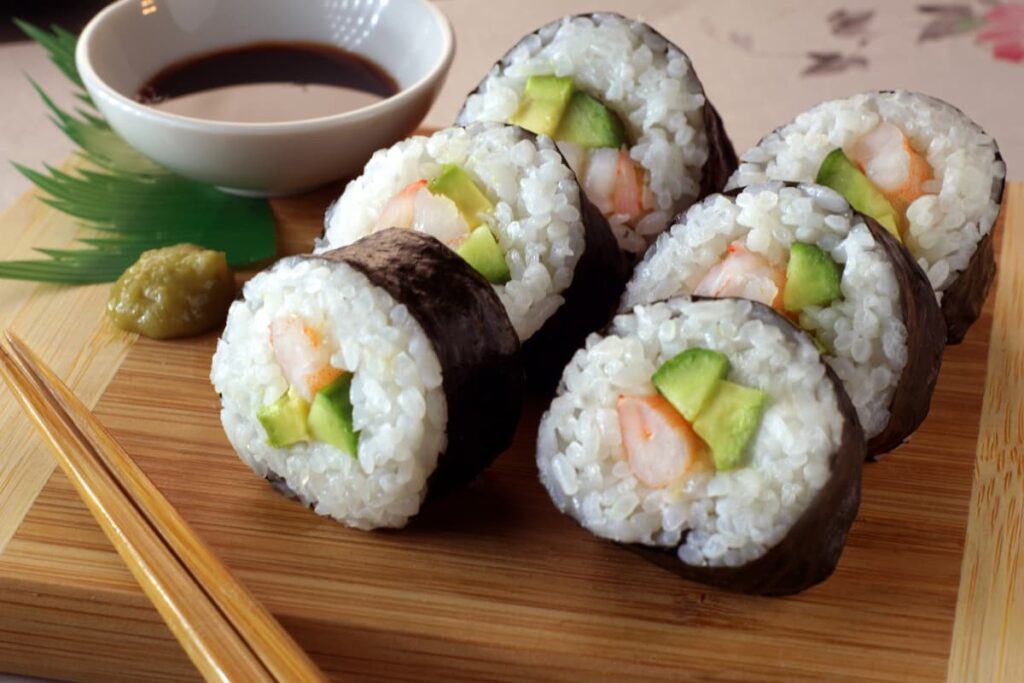Safeway has a wide selection of sushi rolls and nigiri, as well as sashimi for those who don’t like eating cooked fish. You’ll find nigiri made with salmon, tuna, white fish and yellowtail. The rolls are equally diverse in flavor and texture — spicy tuna, eel cucumber and shrimp tempura rolls all make appearances on the menu.

Does Safeway Have Sushi?
Safeway has a large sushi section in its stores. The prices of the sushi are reasonable and they have a lot of variety. Safeway’s sushi comes in many different flavors and styles. If you are looking for something spicy, you can get spicy tuna rolls or if you want something sweet, you can get sweet potato rolls.
Safeway’s sushi is made fresh every day so it is always fresh when you buy it. So if you are looking for some good sushi to eat today, make sure that you go over to your local Safeway store and get some for yourself!
What Types of Sushi Does Safeway Sell?
Safeway is one of the largest grocery store chains in the United States. They carry a wide variety of products and services including sushi. You can purchase your favorite rolls at Safeway and enjoy them at home. There are many different types of sushi that are available at Safeway. The following are some examples:
California Roll – This roll is made with crab, avocado and cucumber. It is then rolled up in rice and seaweed paper. The California roll is an Americanized version of an original Japanese dish called makizushi or “rolled sushi.”
Spicy Tuna Roll – This roll is made with tuna, mayonnaise, spicy sauce and scallions. It is then rolled up in rice and seaweed paper like the California roll above but it has a spicy kick to it because of the mayonnaise and spicy sauce used for it’s preparation which gives it its name, Spicy Tuna Roll!
Sweet Potato Roll – This roll was created in Hawaii by using sweet potatoes instead of regular white rice when making sushi rolls which gave them their unique taste as well as texture that make them so delicious!
How Much Does Sushi Cost At Safeway?
Sushi is one of the most popular foods in the world. It’s made from vinegared rice, and it’s usually wrapped around other ingredients such as fish, vegetables or egg. The main ingredient in sushi is always raw fish, so it’s important to make sure that it’s fresh before eating it. The cost of sushi varies depending on where you buy it and what type of sushi you get.
The average cost of a single roll of sushi at a grocery store is $3 to $5. Some stores have more expensive rolls that can cost up to $25 each! A cheaper option is to purchase pre-made rolls directly from the grocery store deli counter or in frozen packages at the grocery store freezer aisle. If you’re looking for something even cheaper than that, consider making your own sushi using basic ingredients like rice, seaweed, tuna and salmon — these are all available in large quantities at any grocery store for about $2 per pound (approximately 3 pounds).
Is Sushi Good Quality At Safeway?
Sushi is a Japanese food that consists of cooked vinegared rice combined with other ingredients, seafood, vegetables and occasionally tropical fruits. The word sushi comes from su (vinegar) and shi (sour or fermented).
Safeway has a surprisingly large selection of sushi. In fact, it’s one of the best in the area. You can find everything from tuna rolls to crab salad in the deli section of your local Safeway store. And if you’re looking for something unique, they also have something called “California rolls” which are made with cooked salmon instead of raw fish!
Does Safeway Offer Sushi Through Instacart?
Safeway sells sushi in many of its stores and through online delivery service Instacart. The company offers several types of sushi rolls, including spicy tuna roll, California roll and spider roll. It also sells nigiri dishes such as salmon sashimi and yellowtail sashimi.
The grocery chain sells its sushi in two varieties: ready-to-eat or freshly prepared. The ready-to-eat varieties are pre-made and come with a plastic container that can be microwaved or put in the freezer to keep them fresh longer. Freshly prepared varieties are made on demand and include ingredients like salmon and tuna that need to be cooked before serving.
Conclusion
Safeway has a variety of sushi options, including California rolls and spicy tuna rolls. If you’re looking for something different, the grocery store also offers ahi tuna and salmon nigiri. For any questions about our Queryreview article comment down below.
FAQ’s About Sushi At Safeway
Sushi is a Japanese food consisting of cooked vinegared rice combined with other ingredients such as seafood (cooked or uncooked), vegetables and occasionally tropical fruits. Styles of sushi and its presentation vary widely, but the key ingredient is “sushi rice”, also referred to as shari/shari rice. The term sushi is no longer used in Japan, having been replaced by terms like nigirizushi (“hand-pressed sushi”).
Sushi At Safeway provides you with essential nutrients such as protein that aids in muscle growth, carbohydrates that helps to keep you energized throughout the day and vitamin B12 which helps to maintain healthy blood cells. It also contains Omega 3 fatty acids which help to lower cholesterol levels and reduce inflammation in the body.
Sushi At Safeway contains proteins which help repair damaged cells in our body; carbohydrates which provide energy for our muscles and brain; fats, oils and dietary fiber which help us absorb fat soluble vitamins A, D, E & K
Sushi At Safeway sells sushi rolls, nigiri and sashimi.
Yes. The Food and Drug Administration recommends that pregnant women, children, seniors and people who have compromised immune systems avoid eating raw fish. Also, anyone can develop an allergy to shellfish or other types of seafood.
